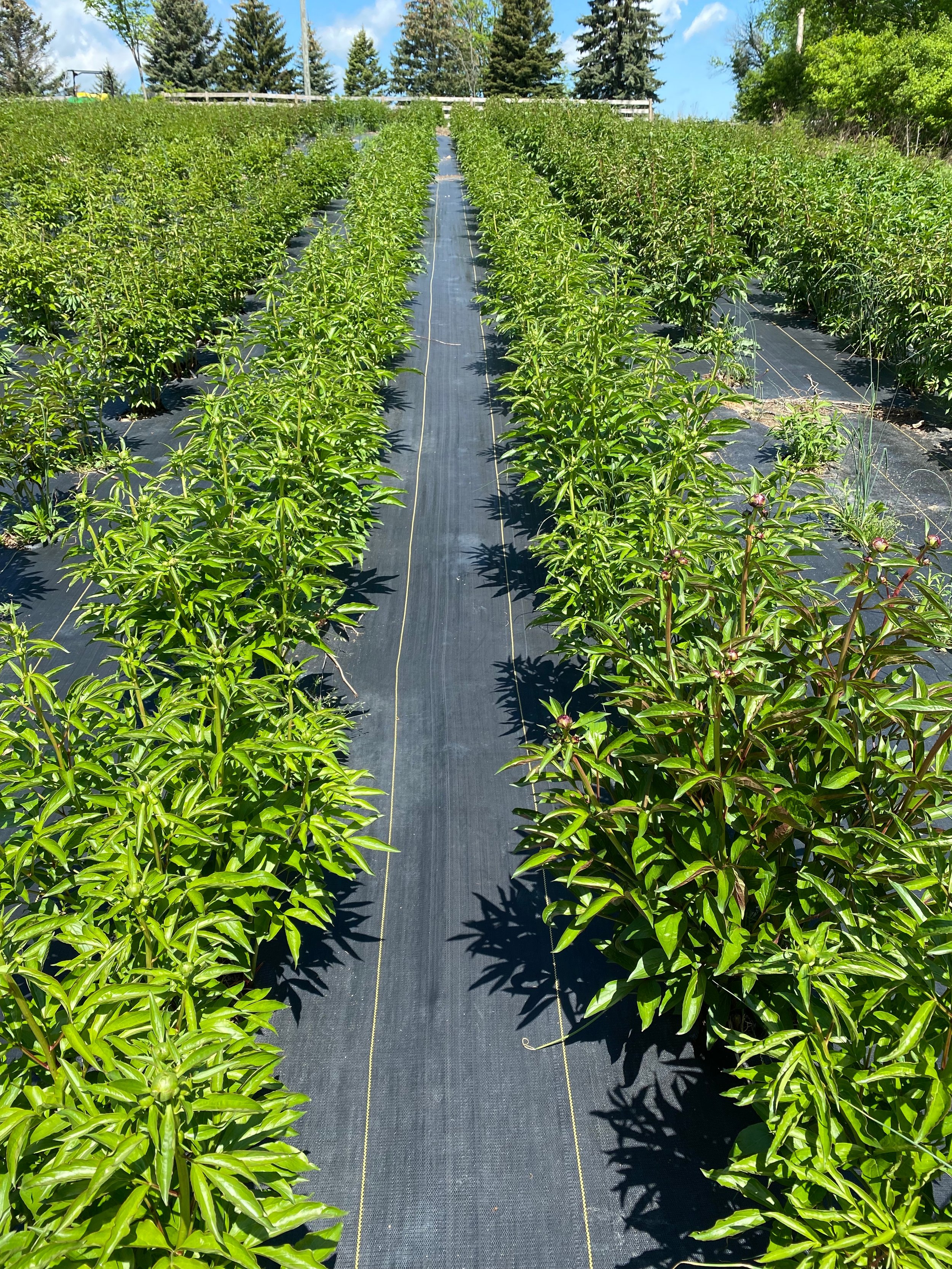Peonies: A Profit and Expense Guide for Flower Farmers
If you follow me on Instagram, you’ve probably seen me refer to my peony field as “My husband’s retirement gig.” Let me explain why.
Once a peony is established—which takes years—a single plant can produce more than 50 blooms a year. Let’s be incredibly, uber conservative and say that you harvest 15 stems per plant each season and charge a low price of $4 per stem. This would mean each plant would bring in $60 in sales per year.
With 4,000 plants, that’s a gross income of $240,000.
If I wholesale them for $2 per stem, it’s $120,000.
At just $1/stem, it’s $60,000.
I’d be happy with any of those amounts! These figures are why I often refer to the peony field as Rob’s (my husband) retirement gig!
But let’s get into real numbers—both income and costs.
Income
When we think about income from peonies, we can always fall back to this simple calculation:
Stem Quantity * Stem Price
Stem Quantity
To plan into the future, I like to match the age of the plant to the number of stems I expect to harvest. With this formula, your first 1-3 years will be a little wonky and generally less. And as you get into the later years, the growth will exceed this formula. But it gives you a good idea for those middle years.
For example, in year 5, I plan to harvest 5 stems per plant. In year 9, I plan to harvest 9 stems per plant. Make sense?
Year 1: unpredictable and not recommend to harvest
Year 2: unpredictable and not recommend to harvest
Year 3: 3 stems
Year 4: 4 stems
Year 5: 5 stems
Year 6: 6 stems
Year 7: 7 stems
Year 8: 8 stems
Year 9: 9 stems
Year 10: 10 stems
If you have 1,000 plants, you would have around 3,000 stems in year 3, 4,000 stems in year 4, and so on.
Stem Price
The price you can fetch per stem can vary significantly and is influenced by several key factors. Understanding these factors can help you not only set realistic prices but also strategize for better profitability.
Variety: Different varieties command different prices. The more rare or in-demand a variety is, the higher the price it can fetch. Exclusive or unusual colors and shapes often attract premium pricing.
Season and availability: The timing of your harvest can impact prices. Peonies in full bloom at the start of the season, or off-peak times when fewer peonies are available, might sell at a premium due to high demand and lower supply. Just look at Alaskan-grown peonies. Because of Alaska’s weather, their peonies bloom in the summer during prime wedding season, when other locations’ peony season has ended.
Local economy: Your prices will depend on the economy and average income in the area where you sell. In places where people generally earn less, you might need to lower your prices to sell your peonies.
Distribution channels: And finally, where and how you sell your peonies will have the greatest effect on how much you can get per stem. Direct sales to customers—like at farmer’s markets or through a CSA—will fetch a completely different price compared to wholesale to florists or retailers.
When it comes to stem price, you really want to nail down how you plan to sell your peonies prior to going in because this will greatly affect income potential. You also want to look at what you have to give in terms of time and energy to peony harvest and marketing. I charge between $3 and $4 per stem.
Initial Expenses
After exploring the income potential of peonies, it’s equally important to understand the costs involved. From initial planting and ongoing maintenance to harvesting, each stage of peony farming incurs specific expenses. Getting a clear picture of these costs is crucial for a balanced and realistic view of your peony farming profitability.
Roots
When considering the costs of peony farming, one of the primary expenses is the cost of the roots themselves. The wholesale cost of common varieties known for great cuts will cost around $5 per 3-5 eye root. (Yes, you read that right!)
This initial investment will be the majority of your startup costs.
1,000 roots = $5,000
2,500 roots = $12,500
5,000 roots = $25,000
Weed Prevention
This can be an initial investment and/or a recurring expense. Effective weed management is essential in peony farming. There are plenty of options: herbicides, cover crops, companion planting, or even weeding by hand.
My preferred method is landscape fabric. While it can be a substantial investment, it’s long lasting and I like the clean look. I purchased ours from Johnny’s Selected Seeds in rolls of 300’ by 15’. With landscape fabric, you’ll also need to purchase staples to keep the fabric in place.
Land Development and Preparation
Before planting, evaluate if you need to clear trees or brush on your land. In our case, we started with a part of our property that was overgrown and had a few trees. We cleared the trees and used a silage tarp to eliminate the brush. Although we tilled the soil before planting, we chose not to add compost or amendments.
Cooler Storage
Proper storage is essential for harvested peonies, as they need to be kept cool until they’re sold. During the first few years, a cooler won’t be necessary since you aren’t harvesting stems. But once you head into year three, a cooler becomes important. You have the option to either purchase a ready-made cooler or construct one yourself.
Irrigation
We are located in Plymouth, Michigan which is 20 miles west of Detroit, zone 6A. We’ve never irrigated our peonies. To be honest, we can’t. We don’t have water access on our back lot where the field is located. We generally get rain once every week or two, more sporadic at times. In 2023, we had weeks without rain during peak peony season, and they still bloomed as planned!
But if you live in a location where you will need to supplement with irrigation, that is an initial cost to consider.
Transportation
Unless your field is directly next to your cooler, you’ll likely want some type of transportation to move your peonies from your field. Carrying full buckets of peonies a distance is exhausting! Consider a wagon, golf cart, or side-by-side.
Recurring Expenses
We just looked at the initial investment for peonies. It’s also important to consider the recurring expenses required for maintaining your field. Understanding and planning for these expenses is crucial for the sustainable management and profitability of your peony farm over the long term.
Plant Care
You’ll want to include the cost of amendments, treatments, and preventatives in your ongoing expenses to ensure the health and vigor of your peonies. In the four years I’ve had the peonies, I’ve purchased one large bottle of fungicide that I have yet to use and an herbicide that I spray in the spring to prevent weed seeds from germinating. No amendments.
Harvesting
While these expenses aren’t substantial, you should still account for flower buckets and snips and anything you use to clean them.
Packaging
Your packaging will be determined by how you sell your peonies. Will you sell direct to consumers? To florists? Or wholesale? Each customer will want and need different packaging. Some packing options include buckets, logo tags, sleeves, and jars.
Holding Expenses
We talked about the upfront cost of a cooler, but you should also think about the ongoing costs for the electricity to power the cooler. Also consider other supplies that help with longevity, like flower food and holding solutions to maintain their freshness. For what it’s worth, I don’t use flower food or holding solutions.
Sales and Marketing
The flowers don’t sell themselves, right?! Don’t forget about any recurring marketing expenses that help you promote your flower farm, like email marketing platforms, website costs, social media ads, and any other advertising you might do.
Haven’t started marketing your farm yet? There are lots of ways to market your flower farm before you even begin selling blooms.
Maintenance Costs
This includes regular upkeep of your property, including the cooler, air conditioning units, transportation vehicles, irrigation systems, and other essential equipment.
Labor and Time
The recurring expenses for running a peony farm that we’ve discussed thus far are pretty manageable, leading us to our main expense: labor. This is the core of your farm’s recurring expenses and can vary greatly based on your style or approach.
The recurring labor involved in growing peonies is fairly straightforward.
Each spring I apply an herbicide to prevent weed seeds from germinating. This process—including attaching the sprayer to our gator, filling it, and spraying the field—takes less than two hours two times per season.
Then, I need to monitor the field for blooms, problems, and pests.
Then it’s harvesting. With the age of our plants, I can harvest from the 2000ish plants that are in production in 2-3 hours each day. I’ll have a few days that are shorter and a few that are longer, but 2-3 hours each day during harvest has been the norm.
This number will increase as the plants mature. But I don’t plan to work much more and let me explain why.
While we’ll always offer some type of flower subscription, I love the u-pick approach. Why? Less labor. By selling our blooms via a u-pick, magic happens. I don’t need to harvest the stems. I don’t have to “catch” them at the perfect time. I don’t have to store or transport them. It simplifies the process.
As I age, I’m looking to simplify my farm, not grow a large team with a lot of production. I just want to grow the incredible field and let my customers soak it in and enjoy the experience. This also eliminates a lot of expenses, including a huge chunk of labor.
The main drawback to this method is that I need to be a pro marketer to attract customers. But I love marketing so I’m up for the challenge.
(If you struggle with marketing and sales, be sure to check out my signature course, Muddy Business. In Muddy Business, I share my proven system to price, market, and sell your flowers.)
And finally, I’ll cut down the field in the fall. Heck, one year I hired a landscaping company to do it and it was worth every penny. They completed the task in just one day. To cut down on costs, you can do it yourself with tools like a weed whipper, brush hog, or traditional clippers.
To summarize the labor of peony farming, it’s relatively minimal, with short bursts of activity during two key periods: the harvesting season and fall cleanup. Both stages require effort, but they are short and manageable, making the overall labor demands of peony farming minimal.
So there you have it - an in-depth look at the income and expenses involved in peony farming! The next step is to create an actual profit plan that will serve as a blueprint for your business.





